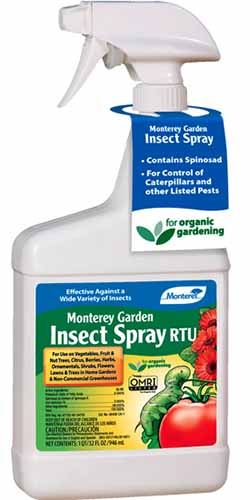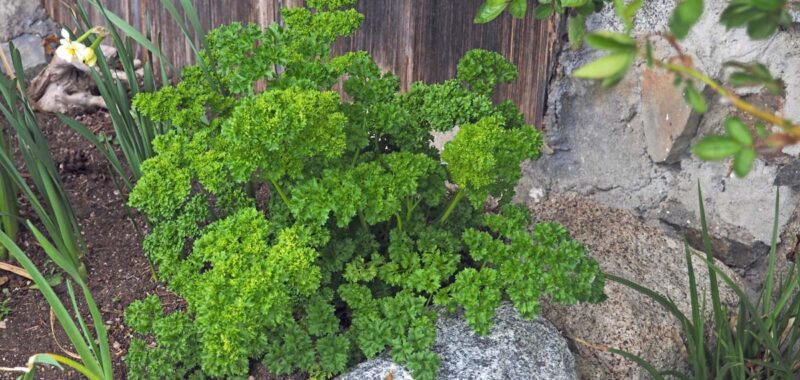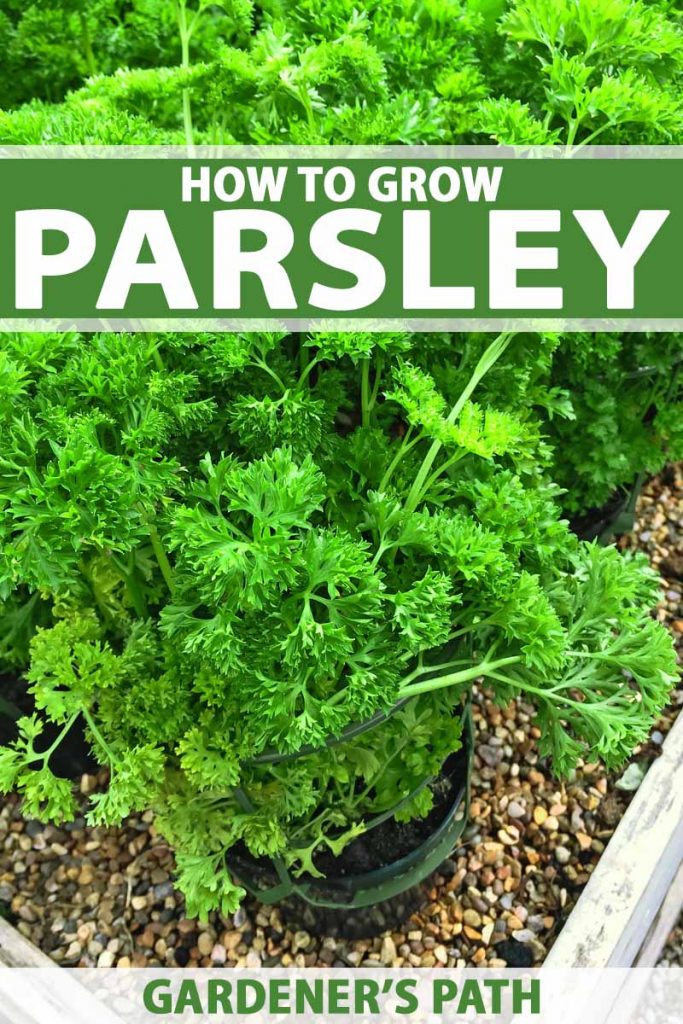Petroselinum crispum
We’re all familiar with parsley, often used as a garnish on our favorite dishes. But its usefulness goes far beyond visual appeal on a plate!
Parsley’s culinary applications are extensive, and it offers many outstanding health properties with beneficial vitamins, minerals, volatile oils, and antioxidants.


We link to vendors to help you find relevant products. If you buy from one of our links, we may earn a commission.
Photo by Lorna Kring.
Read on to learn how to grow your own at home:
Parsley (Petroselinum crispum) is a biennial herb with bright green, lacy leaves that can be either tightly curled or flat.
Native to southern Europe and the Mediterranean, it is a common herb that is used both as flavoring and garnish in the cuisines throughout the region.
Quick Look
Common name(s): Parsley
Plant type: Biennial herb; grown as an annual
Hardiness (USDA Zone): 5a to 9b
Native to: Central and eastern Mediterranean
Season: Spring and summer
Exposure: Full to partial sun
Soil type: Rich and loamy, well draining
Soil pH: 6.0-7.0, slightly acidic to neutral
Time to maturity: 70 to 90 days
Spacing: 1-2 inches from seed, thinning to 6 inches
Planting depth: 1/4 inch (seeds)
Mature size: 1 1/2 feet high
Water Needs: Moderate to high; 2-3 times per week
Taxonomy
Order: Apiales
Family: Apiaceae
Genus: Petroselinum
Species: crispum
Cultivars: Curly, Flat Leaf Italian, Hamburg
It serves as an excellent companion herb for vegetables and roses, and also makes an attractive, textured border plant.
Plus, the aromatic greenery of the curly leaf variety is a striking addition when mixed with flowers in hanging baskets and planters.
Seed heads left in place are appreciated by overwintering songbirds, and parsley is one of the first plants chipmunks will forage under when they emerge from hibernation.
To enjoy the many benefits and applications of this herb, let’s look at the best growing conditions, how to use it as a companion plant, kitchen use and storage, and much more!
How to Sow
Seeds can be sown outdoors in March or April, and again in late summer for early growth the next spring.
Direct sow outdoors in early spring, or once the soil has warmed up, ideally around 70°F.


As parsley seeds are slow to germinate, often taking up to four weeks, soaking the seeds for 24 hours in lukewarm water will help to hasten sprouting.
You may also start seeds indoors eight to12 weeks before the expected last frost date.


Parsley prefers soil enriched with plenty of organic material, such as compost and well-rotted manure. And a pH of 6.0 to 7.0 provides the best range for nutrient absorption and vitality.
Sow seeds one inch apart at a depth of a quarter of an inch, and keep the soil moist. Thin to six inches apart when the second set of true leaves has emerged.
How to Grow
Growing parsley is a straightforward process, but there are some specifics to keep in mind to ensure a healthy, bountiful harvest.
Read on for essential growing requirements:
Light
Parsley thrives in full sun but can tolerate partial shade, especially in hot climates. Ideally, it should receive at least six hours of direct sunlight per day.
In regions with harsh, hot summers, providing some afternoon shade will help prevent the plants from wilting or scorching.
Water
Keep the soil consistently moist but not soggy. Water deeply whenever the top inch of soil feels dry to the touch. This can be as often as three times a week in dry conditions.
Aim to provide one to two inches of water per week, whether through rainfall or supplemental irrigation.
Mulching around the base of the plant can help maintain soil moisture and prevent it from drying out too quickly.
Weeding
Regular weeding is essential to prevent competition for nutrients and water.
Applying a layer of organic mulch like straw or shredded leaves around the plants can also help suppress weed growth.
Temperature
Parsley prefers cool to moderate temperatures and thrives between 50 and 70°F. It can tolerate light frost but may struggle in extremely hot weather.
Hardy to about 10°F, it will lose its leaves during extended periods of freezing temperatures. But new growth will reappear as soon as the days start to lengthen.
The addition of a dry, thick mulch or a cloche will help in areas with severe winter weather.


Plants grown in protected areas – such as up against a wall or building with a southern exposure – with a thick, dry mulch placed around the crowns will continue to produce new foliage in regions with cool winter temperatures.
To enjoy its fresh taste all year, you can always bring a pot indoors during the cold season to sit on a sunny windowsill.
In warm regions, grow parsley in the ground as a fall or winter crop for the best result.
Fertilizing
Parsley is a light to moderate feeder. Incorporate compost or well-rotted manure into the soil before planting.
Fertilizers should have an N-P-K (nitrogen-phosphorous-potassium) ratio of 1-1-1, or you may use a foliage formula of 3-1-2 or 5-1-1.
A side dressing of nitrogen after the first heavy harvest can be applied, as nitrogen promotes leaf growth.


Indian Rivers Organic Fish Fertilizer
Fish fertilizer with a 5-1-1 formula is a good choice for leafy green veggies and herbs. Indian Rivers Organic Fish Fertilizer has an NPK ratio of 3-1-2 and is available via Amazon.
Companion Planting
Plant parsley around the base of rose bushes to enhance their growth and fragrance.


In the veggie patch, grow parsley near asparagus, bell peppers, members of the cabbage family, chives, corn, onions, peas, and tomatoes.
It will enhance that flavor of many veggies, and its volatile oils act as a natural pest repellent. But keep it away from the lettuce patch.
Avoid growing parsley around other members of the Apiaceae family (aka umbellifers) including:
Parsley is susceptible to the same pest and disease problems as these other umbellifers.
Learn more about companion planting with herbs here.
Container Growing
Parsley is well-suited to container growing.
Choose a pot that is at least eight inches deep with drainage holes. Use a high-quality, well-draining potting mix enriched with compost or organic fertilizer.


Water regularly to keep the soil consistently moist but not waterlogged.
Place the container in a location where it will receive at least six hours of sunlight per day. Indoors, parsley will benefit from supplemental grow lights.
Learn more about growing parsley in containers.
Maintenance and Seed Setting
Being a biennial, the sweetest, most flavorful leaves are produced in the first year. In the second year of growth, the flavor will decline somewhat as the plant prepares to flower and set seeds.
Pinching off flower stalks as soon as they appear will help to retain its sweet flavor and extend the plant’s lifespan.
If you do allow seeds to set on some plants, not only will the winter birds appreciate the gesture, you’ll also have plenty of self-sown seedlings early the following spring – and these are easy to transplant.


Allowing a few plants to self-seed is an easy method to ensure you have a bountiful supply of new plants for the garden, and to pot up for kitchen herbs.
Seeds can also be collected in late summer, and stored in a dry, cool location.
Cultivars to Select
Two main cultivar groups are available for home gardens.
Curly Leaf
Curly leaf parsley (P. crispum subsp. crispum), or moss parsley, is used mainly as a garnish, and for drying or freezing.


Curly Leaf Parsley Seeds
It also has a distinctive appearance when used in the garden as a companion plant, or mixed with flowers.
You can find seeds available at Eden Brothers.
Flat Leaf Italian
Flat leaf or Italian parsley (P. crispum var. neapolitanum) is more often used for cooking. It has a deeper flavor, and is easier to handle on the cutting board.
This flavorful herb is widely used in sauces, salad dressings, soups, and stuffing.


It’s also an integral ingredient in classic herb blends such as bouquet garni, fines herbes, and Italian seasonings, and in an herb crust for fish and meat.
Finely minced, it makes a wonderful seasoning served over just picked, homegrown potatoes, salads, steamed veggies, egg dishes, tabouli, and much more.


Flat Leaf Italian Parsley
When used as a seasoning, it also reduces the need for salt – making it a valuable aid for those trying to lower their sodium intake.
You can purchase seeds from True Leaf Market.
Hamburg
There’s also a third, rather obscure type that is used for culinary purposes.
Known as Hamburg, parsnip, or soup parsley, it’s the root of this variety that is actually eaten.


Hamburg Rooted Parsley Seeds
The leaves are very pungent and most folks find them too intense to be palatable. But the parsnip-like roots can be added raw to salads, or added to soups and stews.
You can purchase the seeds in various sizes of packets from True Leaf Market.
Pests and Disease
Parsley is relatively resilient, but it’s not entirely free from pest and disease concerns. Vigilant observation and prompt action are key to maintaining healthy, productive plants.
Pests
Pests can be a challenge for umbellifers such as parsley. Insects and hungry gastropods can quickly cause visible damage or even stunt the growth of the plant.
Aphids
Aphids are one of the most common pests that target umbellifers.


These tiny insects use their sucking mouthparts to feed on plant sap, causing stunted growth, yellowing leaves, plus they produce a sticky residue called honeydew that can attract sooty mold.
If you notice aphids, a strong spray of water from the garden hose can dislodge the pests, followed by an application of neem oil or insecticidal soap if the infestation is extensive.
Encouraging natural predators like ladybugs to the garden by growing plants that attract pollinators can help to keep these pests in check.
Learn more about controlling aphids here.
Cutworms
Another common pest is the cutworm, particularly troublesome for young seedlings. These caterpillars chew through stems at the soil level, causing the plants to collapse.
Protect seedlings with collars made of cardboard or aluminum foil and keep the garden clear of debris where cutworms may hide.
When the plants are established, cutworms aren’t really a problem.
Get more tips on controlling cutworms here.
Leaf Miners
Leaf miners are also frequent visitors to parsley patches. The larvae tunnel through leaves, creating unsightly, winding trails that can reduce the plant’s vigor.
Removing and disposing of affected leaves is the most effective control, though covering plants with row covers can also help.
If you have a serious infestation, you can consider using a product containing spinosad, which is an organic approved biological control made from beneficial soil bacterium.


Monterey Garden Insect Spray
You can find spinosad in Monterey Garden Insect Spray, which is available at Arbico Organics.
It’s a good idea to keep some on hand as it is effective for other types of pests, not only leaf miners.
Snails and Slugs
Snails and slugs can be problematic in cool, damp conditions. They chew holes in leaves, sometimes stripping entire sections of the plant.


Hand-picking, using copper barriers, or applying iron phosphate-based baits can reduce their numbers.
Learn more about controlling slugs and snails here.
Don’t Kill the Parsley Worms!
You may want to think twice before removing or killing any yellow, white, and black colored caterpillars that you spot.
These are the larvae of black swallowtail butterflies and parsley is one of their favorite foods.


They’ll eat pretty much any umbellifer but parsley, dill, and carrot tops rank among their favorites.
Consider planting extra for them to munch on or grow a sacrificial patch of dill to which they can be relocated.
Disease
Fungal disease can affect all umbellifers; they come in a variety of guises and will usually show up during periods of warm, wet weather.
Crown rot, root rot, leaf spot, and Botrytis blight (aka. gray mold) are the most frequent problems, and will appear in persistently wet soil that favors fungi and bacterial growth.
If infected, remove damaged plants, thin to improve air circulation, and refrain from overhead watering. Use a drip line instead.
Bacteria is often present in the soil, which can be splashed onto the leaves from overhead watering, and this in turn infects the plants.
Ensure your garden soil or planters have adequate drainage to prevent soggy soil conditions, and look for disease resistant varieties in areas with high humidity.
Harvest and Storage
Leaves can be harvested when the stem they’re attached to has three distinct and separate segments.
Cut them from the outside edges of the plant, leaving the inner growth to mature.


Fresh parsley will last longer in the fridge if the stalks are kept in a small container of water.
For long-term storage – up to eight months – freezing retains the flavor better than drying. Neither method can replace the taste and texture of fresh parsley.
You won’t be able to use frozen parsley as a garnish, but it’s quite acceptable for use in sauces, soups, and stews.
The Finishing Touch
Parsley brings so many benefits to the table. Isn’t it time to start adding it to your garden, too?
Bountiful in culinary applications, it’s also easy to grow, and beneficial to other plants. It makes a smashing accent in containers, and contributes to our good health as well.


Use it fresh and freeze your surplus, or bring a pot indoors for a year-round supply. And don’t forget to leave some seeds in place for seedlings next spring – and for the birds to enjoy over winter!
What are your favorite ways to use parsley in the garden and kitchen? Leave us a note in the comments below!
And don’t forget to check out some our other herb growing guides such as:



